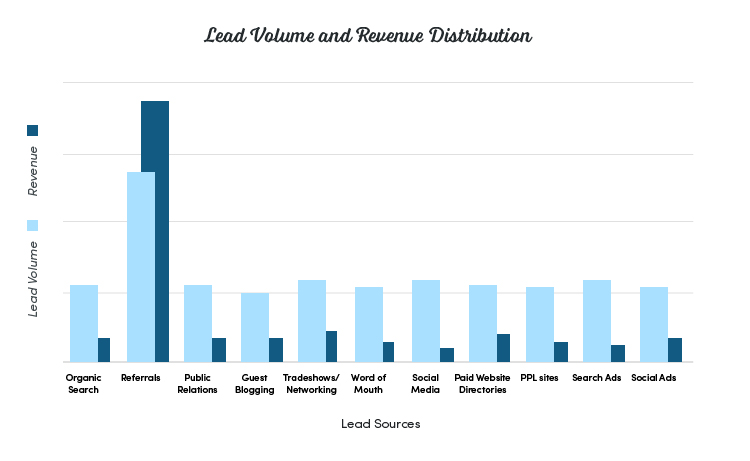
Lead Generation Strategy: How To Close The Loop
Tuesday September 12th, 2017Instead of focusing on volume, your lead generation strategy should start with the goal of closing the loop on revenue generated.
When it comes to developing a lead generation strategy, it’s usually inspired by the sales team. This inspiration comes in the form of… “we need more leads!”
But is having more leads really the answer?
Often, the sales team isn’t analyzing the sources of their current leads, the actual value derived from each lead source and their close rate. Still, they are pressing for more lead volume because more feels better.
This is what I think of…

In a recent article, I looked at the danger of having too many leads coming from a single source that you don’t control: Lead Generation Strategy: Rent vs. Own. What I’m sharing with you here is an even riskier problem… when your lead generation strategy is not only predominantly coming from a single lead source, but to make matters worse, that single lead source is responsible for a majority of your new business revenue.
To identify this potential issue, we need to make sure we are closing the loop on our lead generation efforts with appropriate tracking.
How Do I Close The Loop?
Closing the loop means that you are tracking your sales and marketing efforts from the initial lead source through to closed deals and revenue. This way you know exactly what sales and marketing efforts and channels are driving your business.
- Make sure you have the proper analytics tools in place to track the source of your leads. We mostly use a combination of Google Analytics, Kickfire and CallRail, but there are many other tracking tools out there.
- Connect the lead source information from your analytics tools to a CRM or leads dashboard. Some good options for CRMs are Base CRM, Salesforce and Prosperworks.
- If your organization is not ready for a full CRM rollout and integration with analytics tools, there’s a simpler solution. Start by keeping tracking of the leads in a Google Sheet. When we implement this with clients, we automatically populate marketing source information for inbound leads and we ask the clients to manually rank leads and keep track of which leads they close and which ones they disqualify. This is a very simple way to start collecting info that can be used to close the loop on our sales and marketing efforts. It also does wonders to connect your sales and marketing teams that often work in silos.
- Establish a system for making sure that your marketing and sales teams communicate around this data with questions like “Which sources are driving the highest quality leads, instead of quantity?” and “Which marketing efforts are driving the most actual revenue?”
At the end of the day, it doesn’t matter how simple or complex your system for closing the loop is, as long as it’s working. The goal is to have your sales team tracking not just volume, but also revenue and lead sources by closed deal, all in the same place.
Ok, so now you’ve successfully closed the loop, tracking your leads all the way through to contract or sale, and you see something like this.

This is the scenario I was warning you about. Would you ever invest your life savings into a single volatile tech stock? Then why be comfortable doing this with your business?
If all of your success (both lead volume and revenue) rides on a single lead channel, you better think about diversification.
Lead volume is a soft indicator. Know what revenue each lead source is bringing you. Close the loop.
Let’s say you’ve done the analysis and you’re already concerned that a single deal source is raking in 78% of your leads. To close the loop, you’ll want a critical mass of leads to closed deals. Make sure you don’t start making decisions based on a few.
Let me present four different companies, each in this same scenario, but with a different lead generation strategy.
Scenario 1
The primary lead generation source is a rented property, like an industry directory, that’s generating 78% of your leads. Although it’s bringing in 78% of leads, it only accounts for 24% of deal revenue over the last 2 years.
Good or Bad?
Well, it depends on your investment in this lead channel and what type of return on investment this 24% of total revenue derives. You also need to look at how much opportunity time is wasted filtering through the high volume of leads that end up in the disqualified column.
Scenario 2
Your primary lead generation source is an owned property. Let’s say it’s organic search traffic to a content hub on your website that’s generating 78% of your total leads. This is not only generating 78% of your leads, it’s driving 82% of total deal revenue over the last 2 years.
Good or Bad?
Well, you’re investing in yourself, so that’s a good thing. It’s debatable whether a single source should ever account for such a high percentage of total leads and revenue, but if it happens, it’s best to be through a property you own.
Scenario 3
Your lead generation is spread pretty evenly across 5 sources. One of those 5 sources brings 3x the revenue of any of the others.
Good or Bad?
A diversified spread across your lead sources is positive. On one hand, you should consider increasing your efforts and spend with the high revenue yielding lead source. You should also try to diversify your revenue across lead sources, which means continuing to optimize and experiment with your lower performing lead sources.
Scenario 4
Your lead generation is spread pretty evenly across 5 sources. The revenue generated from three of those sources is pretty even. The revenue from the other two sources is really low.
Good or Bad?
Low revenue yield across somewhat high volume lead sources is not a good sign. Consider shifting budget away from the low performing sources and into the higher performing lead sources while you experiment with new lead generation strategies. This means keeping some of your budget for experimentation.
Conclusion
While none of the four scenarios above are exactly what you want, that’s okay. The point here is that you are able to track lead sources all the way through to percentage of total leads and revenue. This is the first step in optimizing your sales and marketing efforts.
Interested in discussing specific lead gen strategies and challenges? Feel free to connect with me on Twitter @jaybrew